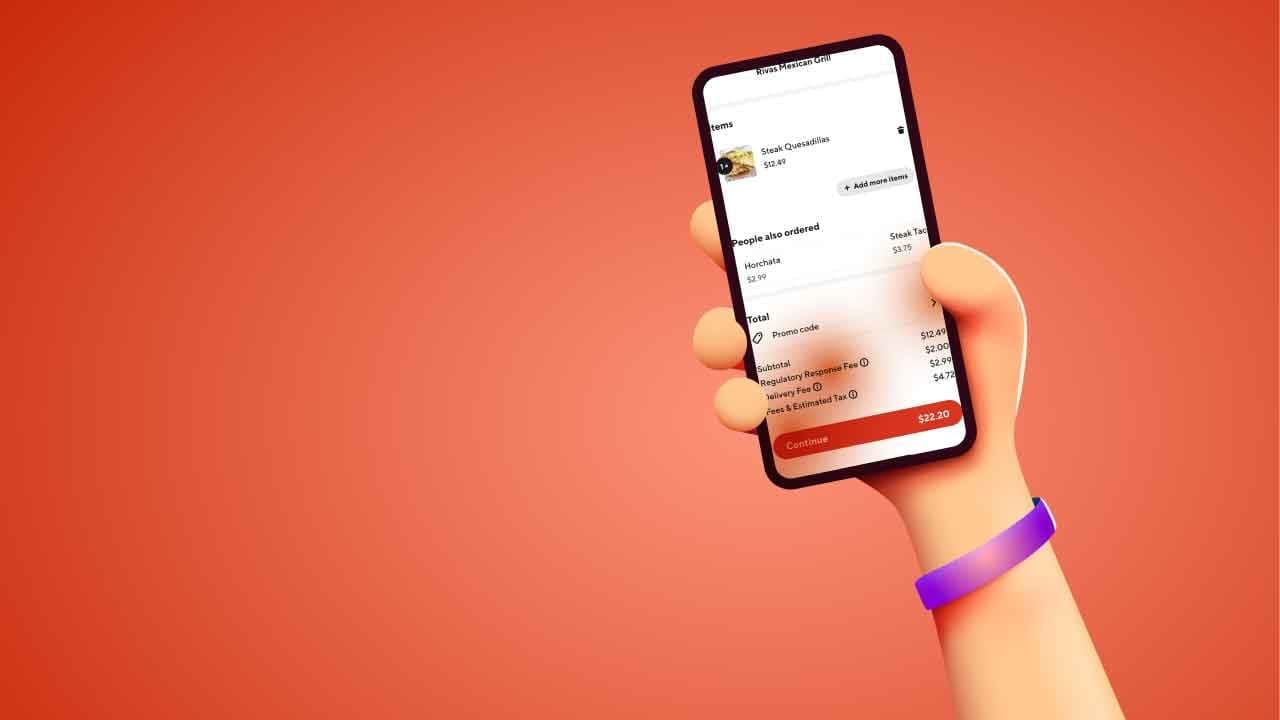Understanding the Regulatory Response Fee, DoorDash


Bestreferraldriver is supported by its audience. We write our articles independently but we may earn affiliate commissions when you use links on this page.

Did you know that the food delivery industry in the United States was worth 22.4 billion dollars in revenue in 2021? Or that Doordash is such a popular app it received over 37 million downloads in 2021?
Thanks to the pandemic, the food delivery industry saw its biggest five years of growth yet, and it's only going to keep growing. By 2029, the food delivery service industry is supposedly going to reach above three hundred billion dollars.
When someone orders food through a delivery service, they get charged a variety of fees. One of these is the recently placed Regulatory Response Fee (DoorDash.)
This fee helps make sure Door Dash can follow local laws and regulations, including ones related to food safety.
You might think that the regulatory response fee seems like an arbitrary charge, but you would be wrong. DoorDash is eager to provide the highest quality food possible, and the fee helps us to do just that.
The Regulatory Response Fee for DoorDash plays an important role in ensuring food safety and health. If you are ready to find out what that role is, then you've come to the right place! We will explain everything that you need to know.
The Regulatory Response Fee for DoorDash may sound complicated or expensive, but you have no need to stress. It's actually a lot more simple than it sounds and the cost is comparatively very small.
This fee helps DoorDash offset the costs of complying with new or revised regulations.
When the pandemic began to cause the rapid growth of the delivery service, food delivery places saw an opportunity. They started to offer a program to connect restaurants with third-party delivery drivers. This saves restaurants money by making it so that they did not have to hire people for delivery services on their own.
To be able to do this, DoorDash charged a commission fee to restaurants that joined this service. Some restaurant owners weren't satisfied with this even though the fee was still far less than they would have paid for hiring delivery staff.
Local governments got involved and placed a cap on how much DoorDash was able to charge for this- no more than fifteen percent per order. As a result of this and other regulations, DoorDash had to make this fee to recoup losses.
The amount of the fee is only based on the actual or expected regulatory compliance costs incurred by DoorDash.
The Regulatory Response Fee will not exceed more than two and a half dollars. So you have nothing to fear.
👀 Related Article: Why Is Doordash So Expensive
The Regulatory Response Fee from DoorDash is a mandatory fee that is being applied to orders in some states of the United States. The cap delivery fee is used to help DoorDash comply with various requirements, be they local laws or new regulations.
The fee is also used to support government lobbying efforts and to help with legal expenses. Local governments have been trying to place more and more restrictions on delivery services, making this a needed expense.
The Regulatory Response Fee is not a gratuity, and it is not voluntary. DoorDash customers are responsible for paying the fee, and it is not optional.
The Regulatory Response Fee is only a few dollars per order at the most. This is mostly depending on the state that the customer lives in.
The fee gets charged to the customer's credit or debit card at the time of purchase, and it is not refundable.
The last thing that DoorDash wants is to make the ability to get food harder on people. In fact, eighty percent of people report that food delivery apps such as DoorDash make their lives easier. This is a major selling point for any food delivery service.
The regulatory response fee that DoorDash charges is used to help us comply with local laws and regulations. These regulations can include ones related to consumer protection, driver safety, and wage and hours.
The fees also help ensure that DoorDash can continue to offer low prices to our customers. By adding this fee, it makes it so that restaurants don't have to hike their prices. This would make it far more expensive for you, the consumer.
In some cases, the regulatory response fee may be higher- such as in markets where there are more stringent laws and regulations.
As stated before, however, it should not put any excessive strain on the customer. For example, the DoorDash Chicago Fee is only a dollar and fifty cents.
Overall, the DoorDash Regulatory Response Fee is actually beneficial for all parties involved!
After hearing about the commission caps put into place by local regulations, it's easy to assume the worst. You might have jumped to the idea that delivery apps were hurting the restaurants by having these commission charges.
The truth is that the commission charges DoorDash used were helpful in the long run to any business who worked with DoorDash.
By partnering with DoorDash to provide delivery services, many restaurants were saved the trouble of hiring delivery drivers, and acquiring the sources to train them and allow them to do their jobs.
The commission fee DoorDash charges is less than the expense that would ever be.
In fact, food delivery services were essential in helping many businesses stay afloat during the height of the pandemic. People wouldn't have been safe to go out to eat, and were actively trying to stay home to flatten the curve.
The restaurants worked to put commission caps into law because they weren't very pleased with the charges they were receiving. Places called "Mom and Pop" restaurants were specifically displeased and felt they couldn't combat the strain.
However, the fact of the matter is that delivery apps cannot provide a service like this for free. Much like the restaurants that complained, they need to make a profit too.
The amount of restaurants that partner with DoorDash only continues to increase. This just proves that partnering with delivery apps is beneficial to restaurants, even if some might find the commission fee placed unacceptable.
As the restaurant industry adapts to the COVID-19 pandemic, DoorDash is committed to making sure the regulatory response fees are fair and understandable. In order to ensure that all customers are aware of these fees, DoorDash has published an article explaining the fee, and how it is being used to help DoorDash's restaurant partners.
One big thing the regulatory response fee helps DoorDash do is to cover the costs of complying with government regulations related to the pandemic, such as increased sanitation and safety measures.
Unfortunately, the repercussions of the pandemic won't be fading any time soon. The measures put in place are here to stay, unless we want to cause another wave of the pandemic by unsafe food practices.
This fee is separate from the service fee that customers are charged, and is used to help ensure that DoorDash can continue to operate safely and compliantly during this time.
This fee may seem unnecessary, but it actually helps protect both drivers and customers. By having this fee in place, we are doing our part to make sure that everyone stays healthy.
Short answer- absolutely not!
DoorDash is committed to providing the highest quality service that they can, for both customers and those who work for DoorDash.
This has repeatedly been proven to be the case. In the case of customers, DoorDash works to provide services such as DashPass to allow cheaper fees for customers. There are also coupons regularly available for customers to use.
As for the people who deliver for DoorDash, there have also been measures put into place to try and help. You may have heard of the "Gas Rewards Program" that DoorDash put into place when gas prices skyrocketed earlier in the year.
DoorDash cares about its consumers and its employees, and will do everything possible to make sure the regulatory response fees aren't a burden.
As of now, currently fifty seven cities have been hit with the need to put the regulatory response fee in place. You may find it is labeled as such, or it might have been put more vaguely- for example, in California there is the " Oakland Fee" of two dollars.
Currently, the DoorDash Regulatory Response Fee has been mostly limited to larger cities such as Chicago (again, under the "DoorDash Chicago Fee" rather than regulatory response fee), St. Louis, or Seattle.
As sixty eight cities have put caps on how much food delivery services can charge for their commission fees, this number may continue to grow.
DoorDash was not the only company hit by these regulations. Apps such as Uber Eats also partner with restaurants, meaning they are also affected.
As the restaurant industry adapts to comply with new regulations, DoorDash is simply one of many companies affected by the regulations that local governments have put in place.
Other companies are also increasing prices and/or introducing new fees to cover the cost of the commission caps put in place.
Delivery services are an unfortunately risky investment at any given time, as they depend on the restaurants that partner with them and the demand for easy access to food from customers. Sadly, it seems like the regulatory response fee is the one way to help combat that.
DoorDash, Uber Eats, and GrubHub are actually working together to try and push back against the regulations currently in place that restrict them. They believe that, as private businesses, it is unfair and unethical that other private businesses are trying to restrict them for their own benefit.
It is a restaurant's choice whether or not to partner with these apps, and many restaurants have made and continue to make that choice.
Even though many places are trying to hinder their progress, it is clear that the company is still growing and expanding. They are currently in the process of expanding their business to Europe and Australia.
In addition, they are continuing to invest in new technology and features to improve your experience as a customer.
While it is unclear what the future holds for the company, it is clear that they are committed to growth and innovation. Part of this growth and innovation includes how best to help both its customers and employees.
DoorDash is currently the most popular food delivery service there is. It's very unlikely that that will change at any point in the near future.
Now that you've heard all about the regulatory response fee for Doordash, we hope that you are curious to hear more.
If you have time, why not check out the rest of our articles?
We offer advice on a variety of food delivery services. Some articles tell how to join them, what benefits they have, or even what ones are cheaper to order from.
We even have articles for those looking to make a living if the thought of working a job on your own time is appealing to you. Take a look at our website today to find out more!
TRENDING